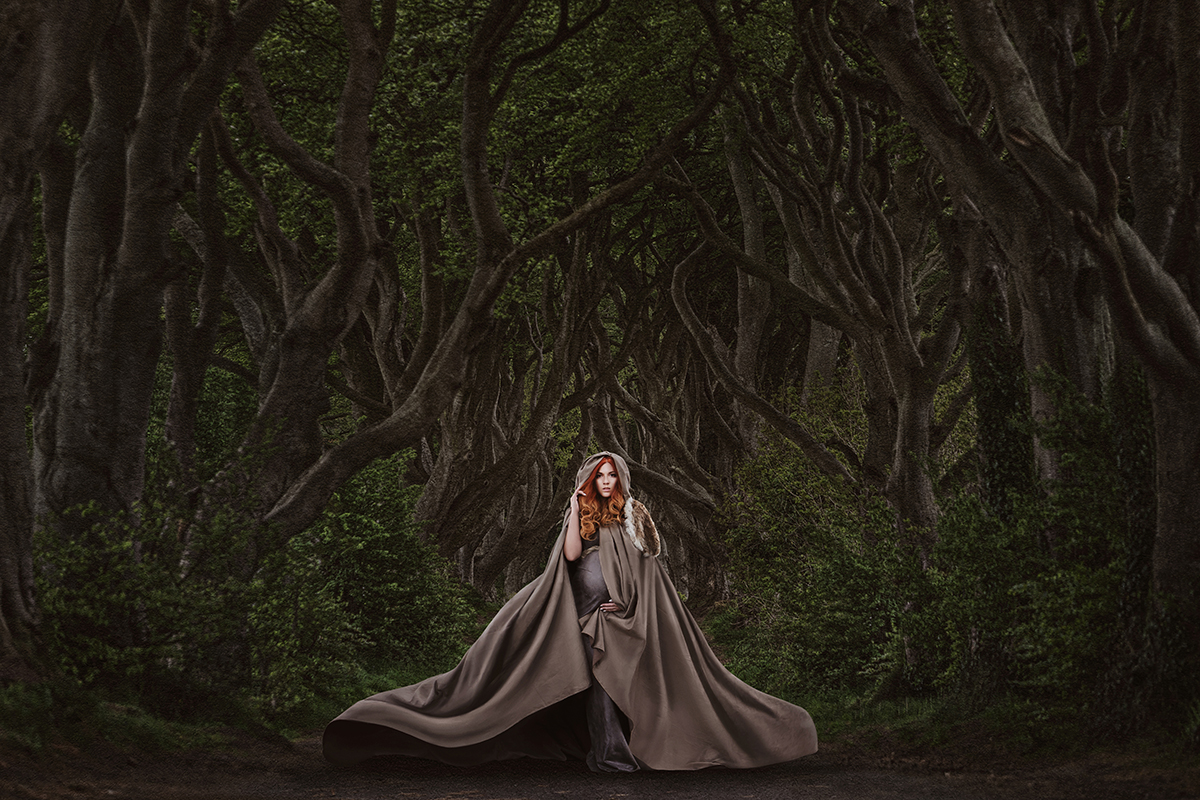The Belly-to-Baby Transition: Maternity and Newborn Photography
Casey Dittmer documents her pregnant "goddesses," and their eventual little ones, with the Tamron SP 24-70mm VC G2 and 70-200mm VC G2 lenses.
More Photo Tips | Video Gallery | Photo Gallery | Enewsletter sign-up
By Jenn Gidman
Images By Casey Dittmer
Casey Dittmer has been taking pictures since high school, when she worked for a portrait studio. College came next, followed by starting her own family—and that's when Casey decided to launch her own studio instead of buying the one she was working at. "We had a new baby, so we started our own business so we could control it and go at our own pace," she says. "We built it from the living room up, from nothing to where it is now."
Located in Grand Junction, Colorado, Casey's studio specializes in portraiture, including family, high school seniors, boudoir, newborns, and maternity, the latter of which Casey has been paying special attention to for the past five years or so. "We've been trying to carve out our niche and change the conversation in maternity," she says. "For so long, maternity photography has centered on a cozier, softer, touchy-feely kind of look, which some women really like. But other women aren't as cool with it. It's just not their personality, or they're not as comfortable in their pregnant bodies as some other women may be."
That's where her studio's "Goddess Experience" comes in. "What we honor is the women's strength in that moment," she says. "We find it's very empowering to celebrate you're having a baby, but also to make a note of what you're accomplishing in bringing a new life into this world. At no other time are women's bodies such a dynamic shape, so we try to showcase them in beautiful gowns."
For all of her different photography styles, Casey relies on the two main lenses in her arsenal: the Tamron SP 24-70mm F/2.8 VC G2 and the SP 70-200mm F/2.8 VC G2. "These have both been fantastic from the get-go, with always consistent performance," she says. "Because I started from nothing and didn't have the budget to buy a ton of equipment, I needed to find a lens that could do everything I needed to do. I love that with these two I can get wider, sweeping shots like the ones you see with my maternity work, but also take advantage of the telephoto end of things to zoom in for more detailed shots on my newborns, giving me the ability to capture just the belly and the hands. Plus, because I shoot completely handheld, the Vibration Compensation (VC) feature on both lenses helps reduce camera shake and keep my images sharp."
Casey creates most of the gowns for the Goddess Experience herself. "We do have a few vendors we purchase gowns from, but 80% to 85% of the gowns you see are custom creations I've created for them," she says. "We style at least one look for each session." And the backgrounds she scouts are often ultimately selected to lend a grandiose feel befitting a goddess. "We want each photo to be unique, almost like an event," she adds.
A well-laid-out plan is required for a successful maternity session. "I need to know exactly what I'm going to do and how we're going to get there, so I'm not fumbling during the shoot," Casey says. "We need to pull off the session as quickly and efficiently as possible."
This became especially important, for example, when Casey and her team captured the maternity photo shown here in the famous Dark Hedges of Ireland. "When you're doing on-location shoots like this, they're overrun by hundreds of tourists on buses," she explains. "You go in with your plan, get the shot, and get out. We got lucky, because when we scouted the Dark Hedges, it was super-busy. But when we came back for the actual shoot, there were only a few people there. Using natural light with a bit of fill for her face, we were able to pull off this photo in a half-hour."
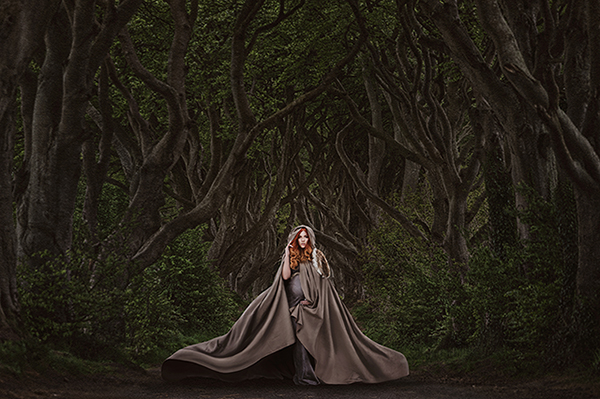
70-200mm (135mm), F/2.8, 1/160th sec., ISO 125
Click image to view larger
How maternity shoots differ from many other types of photography is the added effort needed to keep Casey's subjects comfortable and safe. "Sometimes I have these amazing ideas, but then I realize it's not really feasible to do them without some risk of possibly hurting or exhausting the mom-to-be," she says. "We also try to take breaks as often as we can. When we get excited and are in that high-energy shooting mode, we have to stop once in a while and let our subjects sit, relax, and breathe. Our models aren't just models—they're there as moms-to-be, and you have to be mindful of what their needs are."
That element came into play during her beach shoot in Ireland. "It was cold and blowing rain that day, though you can't necessarily tell that from the photo here," she says. "It wasn't fun for anyone involved. Not only did we have to get her out there safely, but we also had to get her out there and back in fairly quickly, for comfort's sake. It took less than half an hour to walk across the sand, get her into position, fire off the photos we needed, and then get her back down."
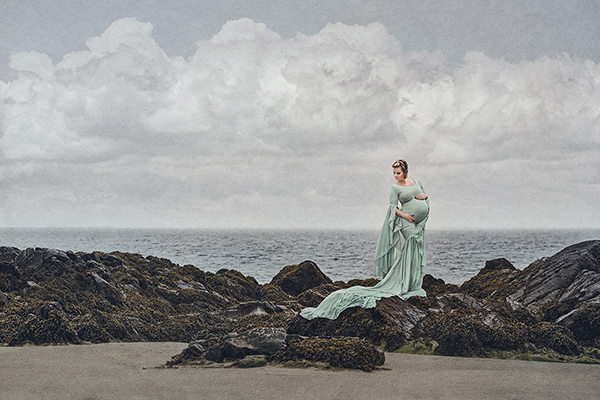
70-200mm (90mm), F/4.5, 1/640th sec., ISO 200
Click image to view larger
Safety and comfort were also paramount for a bucket list–style shoot Casey calls "Bump and a Hump," a photo she'd wanted to do for years. That image finally came to fruition recently in eastern Utah, with the help of a camel called Cosmo. "His smile kills me every time I pull up this image," she says. "We found a place that has camels available for things like this, but many of the national parks that have sand dunes don't allow professional photo shoots. We finally found a place called Little Sahara Sand Dunes that didn't mind us coming in."
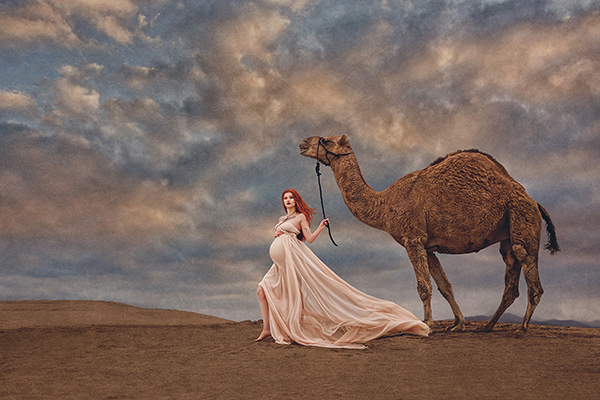
24-70mm (52mm), F/2.8, 1/400th sec., ISO 50
Click image to view larger
But Casey and her team had to be cognizant of their subject's safety. "We had to be careful, because sand is really hard to walk in just for normal people—with pregnancy, that's even more strain on the body," she says. "We had to find shooting locations that looked majestic but that were easy to access, because you can't drag a pregnant woman to the top of the sand dunes."
Casey warns that maternity photos can go wrong fast. "If you don't know what you're doing in terms of body shapes and lighting, you can make their body shape very unflattering, which can damage your subjects' confidence," she says. "For example, you want the bump to be defined but not in a way that makes them look or feel uncomfortable. And that comes down to how we pose them and the proper use of light and shadow."
Switching Gears to Post-Gestation
In her newborn sessions, which she holds in her natural-light studio, Casey adds her own style to photos she hopes to turn into timeless classics. "I don't want to look back in 10 years and know what decade a picture was taken in," she says. "I love textures, for instance, and try to work those in whenever possible. But those kinds of things are all secondary elements. The baby and his or her siblings are the main focus."
The photo of the newborn shown here in a fur wrap is a prime example. "This to me was all about textures: the twist of the wrap, the fur, the wood floor," Casey says. "This baby's family is very outdoorsy, with a lot of those wood textures in their home. But it's still a very simple photo that's focused on the newborn, using the twists of the wrap and lines of the floor to keep everything moving in a certain direction. It offers enough interest so that you want to keep looking at it."
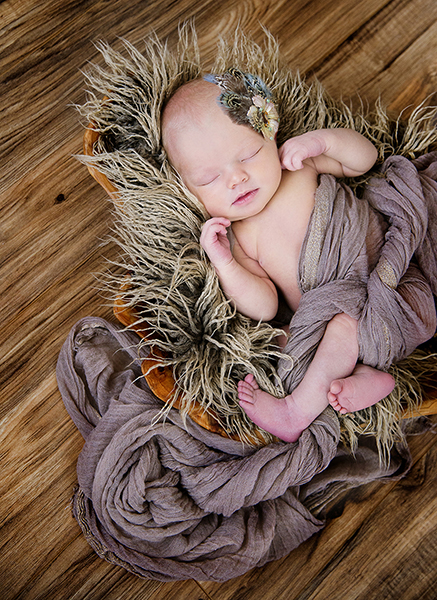
24-70mm (65mm), F/5, 1/160th sec., ISO 800
Click image to view larger
Casey allots a three-hour block for each newborn session to give the parents enough time to settle in and get the baby soothed and to sleep before the actual picture-taking begins. "The baby absolutely calls the shots," she says. "Don't ever think you're in control, because you're not. And this is the parents' first week of trying to get the feedings down, to get used to this human being they now have, so we don't want to add stress to that. Our studio has couches, snacks, and water, as well as a private toy room so older siblings can watch Netflix and play. We really see a difference in the babies' energy, and the parents are so appreciative of the experience."
Much like her maternity sessions, Casey's newborn sessions always follow a plan. "We have a general format we follow for all shoots, with little tweaks we make along the way to customize the session for each client," she says. "For instance, we'll always do basic beanbag photos, then put the baby on something, then wrap them in something—it helps us be efficient and offers our clients a relaxing, satisfying experience. I think the lack of client communication and prep is what kills most newborn photographers, because they haven't laid that groundwork to have a successful session."
Casey also reminds her clients that certain poses aren't "one size fits all." "Customers may come in with 20 different poses they spotted on Pinterest, but I point out that they're all different babies," she says. "Not every pose is possible with every baby: Some don't like their hands being touched together, for instance. Communicate early with your customer that although you'll try, you can't guarantee any particular pose. That way you won't wreck the entire session by putting too much effort trying to get that one pose."
The backgrounds, props, and outfits Casey works into her newborn photos are a combination of clothes and accessories she has in her studio and sentimental items parents bring from home. "We always ask parents if they have specific wants or needs, or if there are colors they like or don't like," she says. "Many times people will know what they don't want before they know what they do want. If they bring props or clothing from home, we look at those items while they're soothing the baby to figure out how to work them in with what we've already got planned."
With slightly misshapen heads, peeling skin, or tiny scratches and bruises, newborns don't always arrive in Casey's studio in pristine condition. "And I tell parents not to worry about that," she says. "If you wait for those tiny little 'flaws' to disappear before you bring the baby in for a session, it may be a week or two, and by that time, the baby will likely be fussier and more alert, making it harder to get them to sleep and to pose them. We can fix all of those imperfections in post-production."
One of Casey's favorite newborn photos are those that incorporate their siblings. "Even when parents tell me they just want newborn pics, we'll advise them bring the siblings to the session anyway, just in case," she says. "We can try to get a photo or two, and there's no obligation to order them later on. But at least let's try to capture something. You want to remember those moments when they're so little and loving each other so much, before they get older and are fighting with each other all the time!"
For the sibling photo shown here, the client brought the newborn's older sister along to the shoot, with no intention to include her in any of the photos. "The parents just wanted newborn pictures," Casey said. "But then I saw the older girl's eyes and said, 'I don't know if you need this picture, but I need this picture.' I simply took a baby wrap and wrapped it around the little girl to create a pretty impromptu top. I kept the colors simple: The focus is on their faces, not on the clothing or the background."
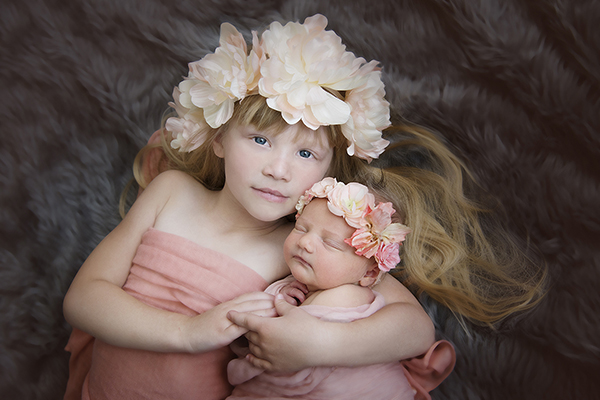
24-70mm (48mm), F/5, 1/160th sec., ISO 800
Click image to view larger
If you're going to include older siblings in the photo, Casey advises to let that simplicity carry over into the posing as well. "Many times you're dealing with younger kids because of the smaller age gap most people have between their kids," she says. "You don't want to do any elaborate or complicated poses that could be risky; you want to keep it safe for the baby. That's why we'll often have them lying down, because even a 2-year-old can lie with her arm cradling the baby on a padded floor, with Mom right there if the 2-year-old decides to bail."
Casey drives home the safety factor once more in describing her final photo, a sweet shot of a newborn hunched over and holding her face up with her own hands. "This picture is a composite," Casey says. "If you see this type of picture being taken with a newborn and it's not a composite, then it's not safe, because it's hazardous to have babies that age propping their head and neck up without support. Instead, I took two separate photos—one of the top half of her head, the other the bottom half, with proper support provided in each—and then merged them together. Safety always comes first in our sessions."
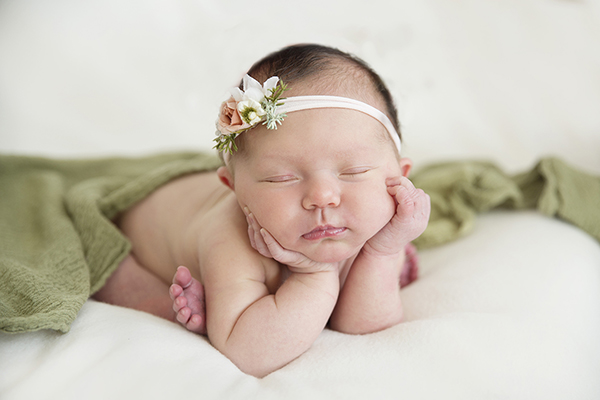
24-70mm (66mm), F/2.8, 1/200th sec., ISO 250
Click image to view larger
To see more work by Casey Dittmer, go to www.cdittmer.com.
More Photo Tips | Watch Videos | Learn More About Tamron Lenses | Photo Gallery
